|
| ||||||||||||||||||||||||||||||||||
| Here we go again.
Yet another climbing trip in the alpine.
There's always another group of mountains to visit, always another few
peaks to knock off the list. That's the problem with mountaineering.
You gotta get to the top, ring the bell, and add the peak to your list of
summits.
Reid, Matt, Stock, and I left Vancouver at 6am on Thursday July 31st. The Fly's right rear tire was showing some metal belt and I needed to stop in Chilliwack for two new tires. I'd checked with Canadian Tire over the phone the night before, who had promised me there were four in stock. Of course, upon getting there, the guy behind the parts desk told me the computer was wrong and they in fact had zero such tires. By this time, we'd worn right through the belt, too much wear to make it to the next Canadian Tire-sized municipality. Luckily, Big O tire up the street had the required goods along with the fastest mechanic in the west, who changed two tires in as many minutes. Back on the road, Stock and I caught up to Matt and Reid in Rogers Pass. Reid: "Hey Matt, Steph's car just passed us!"See Matt's photos and report and Reid's photos and report. |
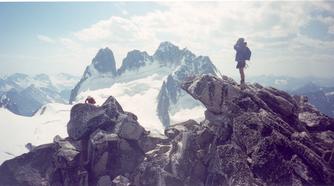 |
|||||||||||||||||||||||||||||||||
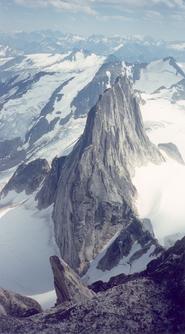
|
The four of us ate spaghetti dinner at the Husky truck stop in Golden and drove
south to Brisco. At this point, Reid "Andretti" Holmes, pushed the
Civic beyond it's usual 80km/h top speed to
dangerously overtake the Fly in a reckless demonstration of street racing.
Reid had understood Stock's and my plan to drive in the lead on the very dusty
logging road. While following their tracks, Stock and I injested several
kilograms of dirt road.
We're hiking at 8pm. We're at the Kain hut at 10pm. We decide to move ahead because "it's only 45 minutes more to Applebee". Of course, that's 45 minutes in daylight. Of course we didn't get to the site until 12:30. So we slept until 7am and headed off for the Kain route up Bugaboo at 8:30 Friday morning. We were at the Bugaboo-Snowpatch col at 10:00, leaving axes and crampons there for the return. The route is great, especially in sunshine. We all enjoyed the gendarme pitch. Snacks and photos on the summit. On our first rappel, the ropes caught. The ensuing knotted mess deep in a thin crack took close to one hour to unravel. Apparently this is common here; be very careful throwing your rope on the first rappel from the south summit of Bugaboo. We made our way back to Applebee for some tasty dinner. Afterwards, we made plans for the next day. Stock and I felt like climbing rock so we settled on climbing the Kraus-McCarthy on Snowpatch; Reid and Matt felt like a short alpine route and chose the west ridge of Pigeon. |
|||||||||||||||||||||||||||||||||
| The four of us left camp at 5:30 Saturday morning. We were again at the col 1.5 hours later. Here we split up. Stock and I headed to the base of the climb where we left boots, crampons, axes, and spent some time looking over the route description, eating food, and lacing climbing shoes. We headed off. On pitch three, Stock carefully made his way over the wet roof. On pitch four, we found ourselves slightly off course, too far right, but worked our way back to the route for pitch five. The upper pitches are quite enjoyable, with great cracks and flakes, and decent pro. Although high, the climb never really feels too exposed since it's in a corner. This has the added bonus that we were sheltered from the wind and had no problems communicating on the climb. After a break on a nice ledge, we made our way to the squeeze chimney. Wow, that thing is narrow. Stock left his pack to be hauled up on the second rope and had a go at it. Looked tough. He worked his way up. Once inside, the crack was so narrow Stock was unable to turn his head. The rack kept getting stuck and he came back down. I briefly checked out an alternative to the left. I tried climbing up the first metre. No good. I tried aiding up the first metre. My second cam spit out of the rock, as Stock put it, "in an explosion of rock particles". Dirty rock, no good. Back into the squeeze chimney. After having watched Stock, I decided to hang all my gear from a sling, and go up with barely more than my knot and chalkbag. This worked and allowed me through the narrow slot and up above. I placed a solid piece and moved up to a small ledge. I placed another cam and took a brief breather, reracked gear on my shoulder, and checked out the book. The topo describes two alternatives: either head straight up the off-width or traverse right to the 5.8 crack. Okay, there's the crack to the right (or so I thought). I placed another cam at the start of the traverse and headed right to the nice large ledge. The ledge was quite secure. I placed a cam, tied a sling around a horn, and hauled up both our packs. I looked up and thought, "Hmm, looks a bit rough for 5.8." The crack is just wider than fists and I had used up my 1, 2, 3, and 3.5 cams. I still had smaller ones and the 4, which was too large for the crack. I climbed up a metre and placed a .4 cam deep in the back. Solid. I climbed up to a good sidepull handhold inside the crack with my left foot on the only foothold outside the crack. Here I placed a #7 nut and a .5 cam in two inner cracks. The rock has a light sandy coating here. These were the best two placements available. Up above was a chockstone. To reach it I would have to layback for two moves. I should have turned back here. I commited and stepped up to the chockstone. It wasn't as positive as I expected. I grabbed it, chalked up, matched hands, chalked up. The chockstone was too large to sling. I stepped up to feel around for holds inside the crack: nothing. I felt around the top: nothing. I stepped back down and matched hands again to shake out. More chalk. I stepped back up and had a look on the other side this time: nothing. I grabbed the left hand side of the top of the crack. It was a large sloper but held. I moved up gently. The chains were 50cm out of my reach. The summit was a dozen metres to my left. I was getting tired. I wanted to step back down, but I was afraid I wouldn't have enough strength to reverse the layback. I moved up slowly, and... slipped. "Falling!" I fell back, keeping my legs and arms out, expecting to catch on the nut and fall against the wall. The nut ripped, and almost immediately, the .5 cam ripped. This flipped me backwards and I fell to the ledge, landing on my back. Ouch! | 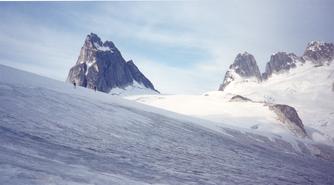
|
|||||||||||||||||||||||||||||||||
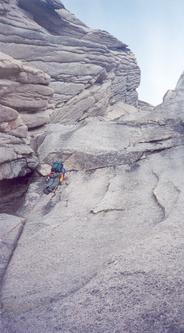
|
Luckily, I was wearing my pack which had inside it fleece and shell to soften the blow. No cuts, but the sharpest pain I've ever felt throbbing in my lower back. I screamed and moaned as Stock asked if I was alright. I described what had happened. Stock stayed cool and told me to take my time. I lay down in the fetal position craddling my back, bending my spine back into the shape. Ouch. Every few minutes, I'd think, "Okay, I have to move now, I can't wait all day." Then I'd try to sit up or stand and... Pow! a sharp stab again. I'd fall back into the fetal position and wait for the pain to settle to a bearable level. After a half hour or so, I set three pieces in three cracks for an anchor and backed it up with a sling around a small flake. I tied the second rope on a figure eight for Stock to haul himself up. Soon he was on the ledge with me. Magically, Stock pulled ibuprofen tablets out of his pack. 400mg down along with some Gatorade. Thanks Stock. In another stroke of good fortune, Robb and John, two guys from Colorado and Alaska, stuck their heads over the top, preparing to rap our route. We explained our situation to them and they offered to help us descend. With four ropes, Robb, John, and Stock established the following system: John would rap on double ropes to the a nice flat ledge near the belay anchor. If it was too far from the rap chains, he'd set a gear anchor. I would rap next, while Stock kept me on belay on a third rope. Upon arriving at the ledge, John would help me tie into the anchor and I'd lie on my side while Stock and Robb rapped, took down anchors, and pulled ropes. This system allowed us to descend safely and allowed me to rest on my side between raps, avoiding the hanging belays. After changing into boots, Stock set one extra rap down the talus and I eventually made my way back to the snow. John helped me get my crampons on and I slowly walked back to the col. Now under complete darkness, John and Robb suggested lowering me four ropelengths over the bergschrund and crevasse. This made my descent much easier and safer. Stock and I then walked to the edge of the talus where we waited while John and Robb rapped over the bergschrund. We slowly made our way back to Applebee by 1am where we awoke Reid (Matt sleeps deeply) and let them know we were back. Thanks to the selfless help of Stock, Robb, and John, I was back on my thermarest. Thanks guys for being solid and getting us all off Snowpatch safely. | |||||||||||||||||||||||||||||||||
|
Sunday I lay on my side all day, cushioned under a pair of therm-a-rests.
Monday Stock and I hiked out
while Matt and Reid climbed to northeast ridge of Bugaboo.
Stock most kindly hiked ahead to the car to return and take my pack
off my when I was only halfway down. We ate in Golden and
slept at The Alpine Inn, a cheapo motel in Revelstoke.
Back in Vancouver Tuesday afternoon.
Wednesday x-ray at the doctors, followed by a CT-scan.
These unfortunately revealed a fractured L1 vertebrae (the L1 is the
topmost vertebrae just below the start of the ribcage).
The muscular backpain has been getting a bit better. The bone will
take six weeks to heal. Luckily, a full recovery is expected.
Canada NTS 82 K/10
Howser Creek 1:50,000.
The Bugaboos. Chris Atkinson and Marc Piché. Elaho Publishing Corporation. 2003. Bugaboo Rock: A Climbing Guide. Randall Green, Joe Benson. Mountaineers Books 2001. Bugaboo Provincial Park website. BC Parks. Bugaboos Provincial Park map (pdf). BC Parks. |
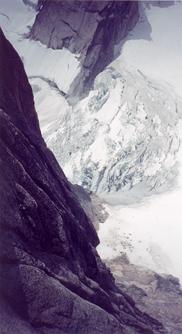
|
|||||||||||||||||||||||||||||||||
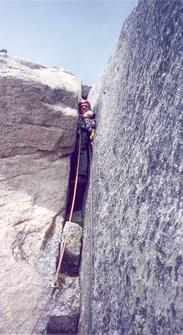
|
Mostly, climbing can be made quite safe. Factors are limitless: who (experience, ability) when (weather, conditions, fatigue, daylight) how (length, gear, natural hazards) where (position, remoteness, exposure) and what (difficulty, protection). Many of these can be controlled. Others can be avoided. A few are uncontrollable. Along the way home, Stock and I talked about how much we enjoyed backpacking before being absorbed into the world of mountaineering. We compared a backpacking trip to a mountaineering trip:
Right. Now during the course of the day, what are the various things you might have to worry about?
Now when things do go badly, they do so on very different levels. A simple mistake in the alpine can be much more costly.
Other than forgetting to bearproof, most consequences of backpacking incidents involve discomfort, nowhere near serious, and definitely not life-threatening. |
|||||||||||||||||||||||||||||||||
|
Again, many of the dangers mountaineering can be safely minimized, kept aware
of,
and mostly avoided by experience, safe gear placement, understanding
the surrounding rock, and climbing at an appropriate grade.
For me, the problem sometimes arises after several hours of safe climbing,
during the 10 seconds when I let down my guard.
On Snowpatch, Stock and I had spent the day climbing safely.
We had taken our time, set good pro, keeping in mind
we could turn around anytime and rap down.
Below the final crack to the summit ridge,
we were basically done the climb.
I should have backed down
when I realized the upper crack was too hard and could not be well protected.
Instead, I figured I only had another
couple metres to the anchor and I decided to move through and finish off
quickly.
I took an unsafe risk and paid for the consequences.
Aside from my backpain, I ruined the rest of the day for
Stock, Robb, and John and put an early end to
Stock's climbing vacation. Helping me off the mountain put their safety at risk.
Solutions? Well, I could make sure not to allow myself to make such unsafe decisions. I believe I do make the right decisions 99.9% of the time, but I don't trust myself to make the right decision 100% of the time. People, and certainly I, will make mistakes. Every climber will make his or her decisions. Many climbers demonstrate experience and level-headedness in rational and wise decision-making under challenging circumstances, allowing them to safely climb difficult routes. For myself, however, for now, I am putting a halt to certain types of climbing: those I consider to have too little room for error.
The elements I love in the alpine can be found in other (safe) places: challenging long days - backpacking and scrambling, technical rock - sport climbing, multiday expeditions - backcountry skiing and backpacking. Perhaps this will allow me to kick this peakbagging bug and stop running up to ring the big bell on the summit to add another peak to the list. I can spend more time with Andrea, friends, and family and focus on activities more social than mountaineering. Perhaps this will allow me to live without the serious injuries I've been lucky to avoid. |
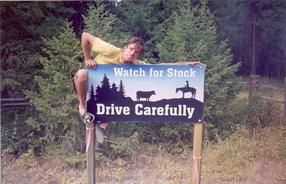
|
|||||||||||||||||||||||||||||||||
 |  |  |
||||||||||||||||||||||||||||||||
